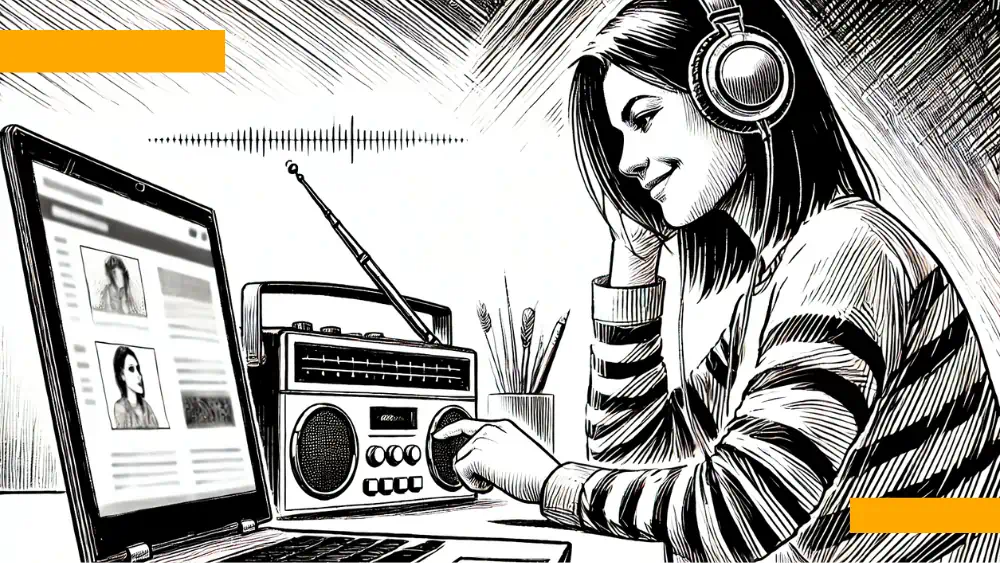 illustration: DALL-E
illustration: DALL-ERadio remains the most popular audio medium, accounting for 51% of total listening time. Music streaming via video platforms such as YouTube makes up 17%, while audio streaming services like Spotify and Tidal account for 14%. Podcasts, although growing rapidly, hold a 7% share.
A closer look at the distribution of different formats:
| Audio Content Format | Share of Listening Time |
|---|---|
| Radio | 51% |
| Music on Video Streaming | 17% |
| Audio Streaming | 14% |
| Podcasts | 7% |
| Audiobooks | 3% |
| Saved Music Files | 3% |
Although radio still dominates, streaming is gaining popularity, especially among younger listeners. As the authors of the Total Audio 2024 study highlight, among the 15–24 age group, streaming services are the primary source of audio content.
Smartphones Lead, but Radios Are Still in Use
The choice of device plays a key role in audio consumption. The report shows that smartphones are the most commonly used device for listening to audio - 65% of respondents use them, and among those aged 15–24, this percentage rises to 90%.
Traditional radio receivers still hold a strong position - 71% of listeners report using them. However, many people use multiple devices depending on their situation and location.
Podcasts Are Popular, but Radio Is the Most Trusted
The Total Audio 2024 study by Adres:Media and the Radio Research Committee shows that one in three Poles listens to podcasts at least once a week, with listenership increasing by 7 percentage points compared to the previous year. Podcasts are particularly popular among the youngest audience - people aged 15–19 listen to them significantly more often than other age groups. This growing interest presents opportunities for creators and advertisers.
Trust in different media is an important factor influencing audience choices. In the Total Audio 2024 study, respondents rated various media on a ten-point scale.
- Radio received the highest rating - 45% of respondents gave it a score of 7 to 10.
- By comparison, YouTube enjoys high trust among 35% of respondents,
- television is trusted by only 31% of viewers,
- and TikTok ranked lowest, with just 16% trust.
Where and When Do We Listen to Audio Content?
The context of audio listening is just as important as the choice of medium. The Total Audio 2024 study shows that Poles most often listen to radio, music, and podcasts in three main places:
- at home,
- in the car,
- and at work.
Each environment favors different types of audio consumption. At home, streaming and podcasts dominate, as they can be tailored to personal preferences. In cars, radio reigns supreme due to its convenience - drivers don`t have to select songs or switch between apps. At work, both traditional radio stations and streaming playlists are popular, allowing background listening without active content selection.
Audio consumption also varies by time of day. In the morning (6:00–9:00), radio is the most popular, serving as the first source of news and entertainment for many people. It is commonly listened to at home while getting ready for work and school, as well as during commutes - especially in cars.
In the evening (18:00–24:00), streaming audio and video content gain importance as listeners have more time to select specific songs, playlists, or podcasts. Radio remains present, but its share of listening decreases in favor of more personalized content.
Audience Demographics: Who Listens to Radio?
The "Audio Track" study by the National Media Institute shows that radio listenership varies by age, gender, and place of residence. Men are more likely to choose RMF FM (19.8%) than women (15.5%), which may be attributed to the station’s news and music format. Eska, on the other hand, attracts younger listeners - 10.6% of those aged 15–29 report listening to it regularly.
Among the 65+ age group, Polish Radio Jedynka (8.6%) and Radio Maryja (4.5%) are the most popular. Older listeners appreciate the traditional nature of these stations and their focus on educational and religious content.
A geographical analysis shows that listeners in large cities prefer commercial stations like RMF FM and Radio ZET, while in rural areas, Radio Maryja enjoys greater popularity.
Daily reach of stations among selected age groups:
| Radio Station | 15 - 29 years | 30 - 49 years | 65+ |
|---|---|---|---|
| RMF FM | 15.4% | 20.5% | 11.4% |
| Radio ZET | 7.2% | 11.7% | 8.7% |
| Eska | 10.6% | 7.2% | 1.1% |
| Jedynka PR | 0.8% | 1.9% | 8.6% |
| Radio Maryja | 0.0% | 1.2% | 4.5% |
| TOK FM | 2.4% | 4.7% | 1.8% |
| Radio WAWA | 4.1% | 2.6% | 0.5% |
| Chillizet | 3.8% | 2.1% | 0.3% |
| Polskie Radio 24 | 1.2% | 1.6% | 3.2% |
Radio Listening Habits in Europe
Despite changing audience habits, radio still reaches a vast segment of society across Europe. According to the European Broadcasting Union`s "Audience Trends: Radio 2024" report, 82.4% of Europeans listened to the radio weekly in 2023.
- 82% of Europeans listened to the radio weekly in 2023.
- 73% of young Europeans (15–24) listened to the radio weekly.
- Compared to 2018, overall radio reach declined by 3.6 percentage points.
- Among young listeners, the decline was 7.6 percentage points over five years.
The main reason for this trend is the growing popularity of digital platforms and new audio content formats across Europe. Although still widespread, radio must now compete with podcasts, streaming services, and social media.
An interesting trend is the increase in the number of people who listen to the radio more frequently than a year ago - this applies to 14% of respondents. This shows that traditional media still hold a strong position despite the rising popularity of streaming and podcasts.
The full Total Audio 2024 report is available at:
https://badaniaradiowe.pl/jak-polacy-konsumuja-tresci-audio-wyniki-badania-total-audio-2024/
COMMERCIAL BREAK
New articles in section Media industry
Advertising market 2025. Poland, Europe and the World
Marcin Grządka
The global advertising market is growing by 8.8% in 2025 and will reach a value of 1.14 trillion dollars. The industry result in Europe records slightly lower dynamics, at the level of 5.8%. In this comparison, Poland performs clearly above the average. We will record an increase of 8.9% this year and a value of 18.56 billion PLN - estimates WPP Media in the annual report "This Year Next Year".
The print media market 2025. Three global trends
Krzysztof Fiedorek
The market value is 359.53 billion dollars, yet the erosion is visible to the naked eye. The decline for newspapers will amount to -2.3 percent. Despite this, print retains strength: it generates 76 percent of subscription revenues and enjoys 82 percent consumer trust. The future of the industry is defined by hybrid strategies and niche specialization.
Journalism in the age of AI. Why people prefer humans over machines
Krzysztof Fiedorek
Only 12% of people accept news created solely by AI, while 62% prefer those written by humans. At the same time, only 19% notice labels indicating the use of artificial intelligence, while younger audiences ask AI to explain the content to them. These are the findings of the Reuters Institute report on artificial intelligence in media.
See articles on a similar topic:
DAB+ Radio. What is Digital Radio Broadcasting?
Krzysztof Fiedorek
Digital radio broadcasting technology, compared to traditional analog radio, provides higher sound quality, better resistance to interference, and more additional features during transmission. However, it’s not without drawbacks and raises concerns among broadcasters.
Cyberviolence and hate disguised as a joke. The RAYUELA report on youth
Krzysztof Fiedorek
The study conducted in five countries reveals a harsh truth. Online violence is not evenly distributed. It is a digital map of prejudice that hurts the most those who stand out the most. "It’s just a joke." That’s how violence often begins. Young people go through it in silence.
Work in the media. We have more recruitment offers at Reporterzy.info [LINK]
AUTOPROMOCJA Reporterzy.info
Thanks to cooperation with the recruitment website Talent.com, the database of recruitment advertisements published in Reporterzy.info has been significantly enriched. We invite you to browse current job offers and internships in the media and advertising industry from the largest Polish cities.
Paid journalistic content. Market trends and forecasts by Reuters Institute
Krzysztof Fiedorek
Only 18 percent of internet users pay for online news access, and the rate has not increased for the third year in a row. Norway sets records with 42%, while Greece does not exceed 7%. Globally, nearly one in three subscribers cancels after a year.





























